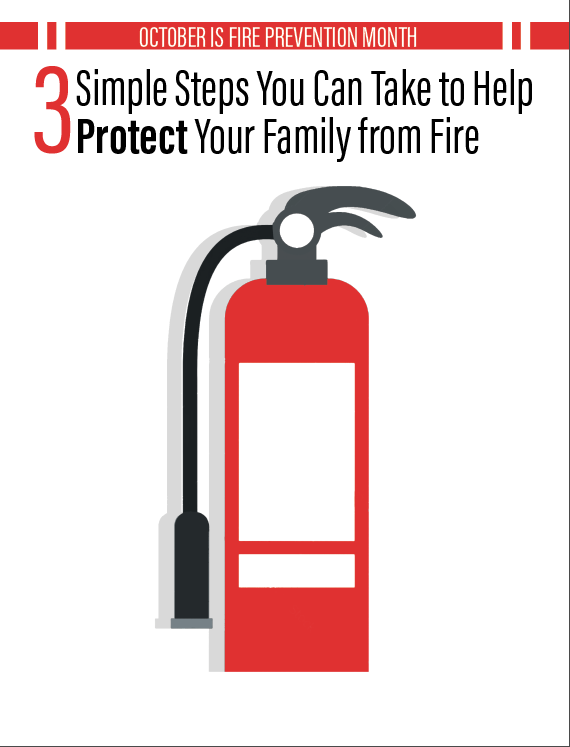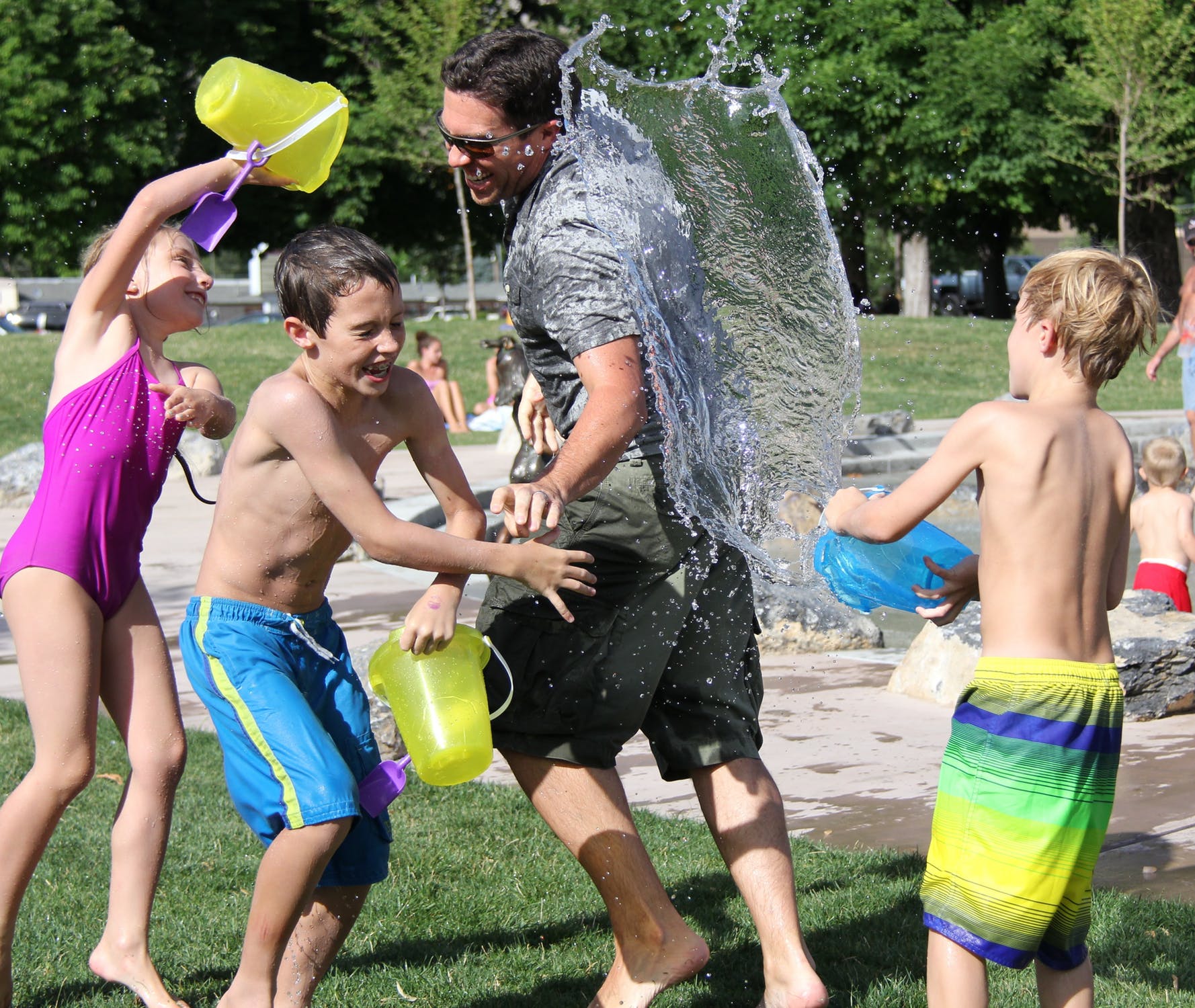Fire Safety Month
 When a fire ignites in your home, it can spread rapidly. It used to be that families had up to seven minutes to escape once their smoke alarm sounded, but many homes these days are built with lightweight construction materials, which burn faster than solid wood. Your family could have as little as two minutes to escape safely once the smoke alarm sounds. But by taking three simple steps, you and your family can make your home as safe as possible from fire and know what to do if a fire breaks out.
When a fire ignites in your home, it can spread rapidly. It used to be that families had up to seven minutes to escape once their smoke alarm sounded, but many homes these days are built with lightweight construction materials, which burn faster than solid wood. Your family could have as little as two minutes to escape safely once the smoke alarm sounds. But by taking three simple steps, you and your family can make your home as safe as possible from fire and know what to do if a fire breaks out.
Look for Places Fire Can Start
Pay attention to your surroundings. Looking for potential “hot spots” in your home can be a family affair. Get the kids involved in a fire-safety scavenger hunt. Let them lead the way as you walk around your home and identify potential fire hazards in the bedrooms, kitchen, living room, basement, attic, and other areas.
Ask the kids for their ideas on how any safety hazards should be addressed. Then, make a plan for correcting the hazards. Once you’re done on the inside, take the scavenger hunt outdoors. Walk around the home with the kids to check the gutters, deck, porch, crawl space, and patio. Point out dead leaves, pine needles, or other debris that can burn. Together, make plans to do a cleanup.
Once the hunt is over, give kids a printout of NFPA’s Kitchen Safety Hidden Pics activity sheet (sparky.org/activities) and read with them the safety messages included. Have them point out the safety hazards and the safety features depicted in the activity sheet. Color the sheet together.
Listen for the Sound of the Smoke Alarm
Take the sound of your smoke alarm seriously. Review smoke alarm safety with your kids so that they’ll know what to do if they hear the smoke alarm sound. Explain to them that a smoke alarm senses smoke and will sound if there is smoke in the home, possibly from fire. Give kids a printout of NFPA’s Smoke Alarm Safety Sheet calendar (sparky.org/activities), a handy chart that offers a timely reminder to test smoke alarms once a month. Gather the kids and walk with them throughout your home where alarms should be located—every bedroom, outside of each bedroom, and on every level of the home, including the basement. Make a plan to add alarms if some are missing in those locations. Test the alarms. This will get the kids familiar with the loud sound. Using the check-off box for the designated month on the smoke alarm calendar, have them note whether or not the smoke alarms are working, and make a plan for addressing smoke alarms that aren’t working. Depending on the type of alarm you have, either replace the battery or replace the alarm.
Discuss with the kids that once the smoke alarm sounds or “beeps,” they should go outside immediately with the rest of the family and stay outside until an adult says it is safe to go back inside. Tell them that, if necessary, they can leave immediately on their own. They are not to stop for toys, pets, or other belongings. Explain that when an adult is cooking and the smoke alarm sounds, the adult will determine if everyone should get out quickly. For added fun and learning, download the app Sparky and the Case of the Missing Smoke Alarms (sparky.org/games), which features key fire safety messages presented in an entertaining way.
Learn Two Ways Out of Each Room
Look for the exits. Walk through your home together as a family and identify all of the windows and doors. Every room in the home needs two ways out. Find at least two exits in each room. Have the kids point to the two ways out. One way would be the door and the second way out may be another door or a window. Make sure that all doors and windows that lead outside can be opened.
Make a printout of NFPA’s How to Make A Home Fire Escape Plan (nfpa.org/fpw/safety-tip-sheets) to help you and the kids draw a map of your home, showing each level of your home, all doors and windows, and stairwells. The printable sheets include a checklist for planning and practicing an escape drill, as well as a blank grid and template. Identify all of the smoke alarms in your home and mark them on the grid. Decide on a location for your outside meeting place that is a safe distance away from the front of your home—it could be a mailbox, light pole, or tree. Be sure to draw it on the escape plan as well. If you live in an apartment building, review the building’s evacuation plan as a family. Remind everyone that they are not to use the elevator unless told to do so by the fire department.
Practice Your Home Fire Drill
Put your plan to the test by conducting a home fire drill. Pick the day for the drill, and help the kids make a poster announcing the date. Each day leading up to the drill, spend a few minutes reviewing the important points of the home escape plan: the sound of the smoke alarm, two ways out of each room, and the outside meeting place. On fire drill day, have someone push the test button on the smoke alarm. Watch the kids’ responses to the alarm to see if they take appropriate action.
Get up and walk to your exit. Don’t run, but walk briskly. Shut the doors as you leave. Get outside quickly to the determined safe meeting place. Once the drill is over, have a conversation about how things went. Discuss any challenges or concerns about the drill.
Make a plan to practice your home fire drill at least twice a year with everyone in your home, both at night and during the daytime.
Look. Listen. Learn.
These are three simple calls to action to identify basic but essential ways families can reduce their risk of fire and be prepared in the event of one.
You can find more activities for keeping your family safe from fire by visiting sparky.org and firepreventionweek.org. Fire Prevention Week™ takes place October 7-13, 2018. This year’s theme, Look. Listen. Learn. Be Aware. Fire Can Happen Anywhere.™, reminds us that fires can and still do happen, but steps can be taken to remain safe.
Lisa Braxton is the Public Education Specialist for the National Fire Protection Association® (NFPA®).




